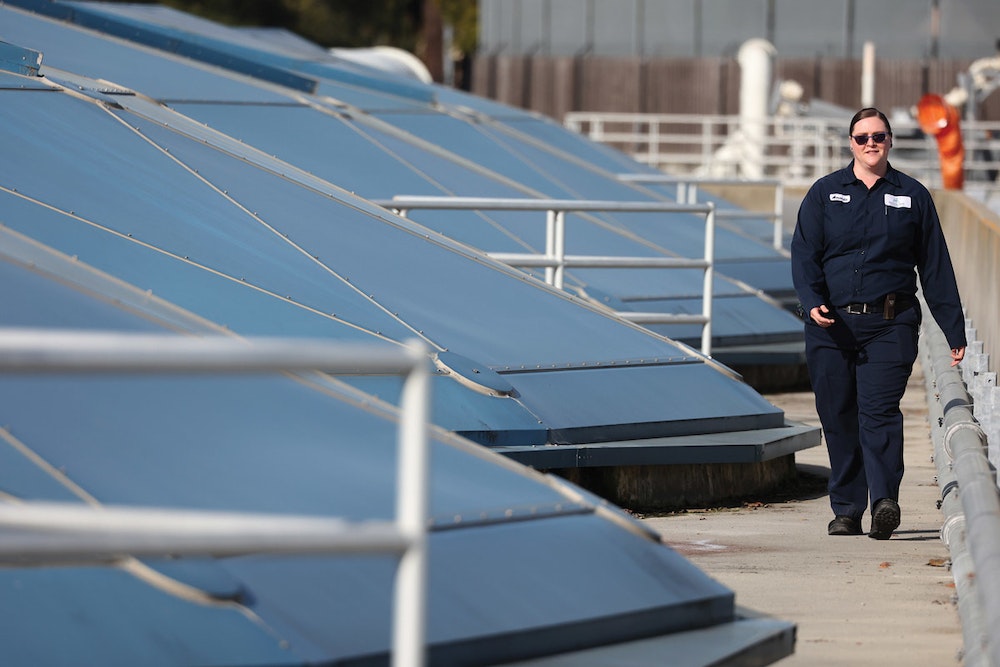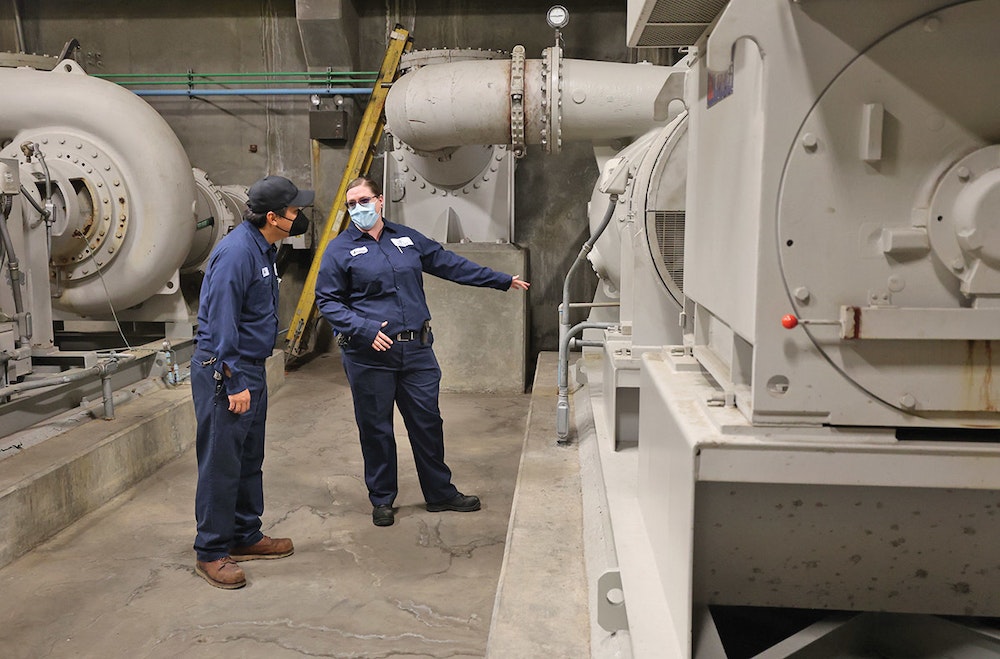
To prove herself in a male-dominated profession, Bird focused on performing to the best of her ability, learned fast, and displayed a strong work ethic. Photo is reprinted by permission by TPO Magazine.
This article first appeared in the July 2022 issue of Treatment Plant Operator magazine, published by COLE Publishing Inc., www.tpomag.com. It is reprinted by permission.
Solar Panels, Cogeneration, Hydroturbines, and Wind Generators Are All on the Net Zero Agenda in Santa Cruz
To Bird, senior wastewater treatment operator and interim operations supervisor, that means obtaining all the power needed to run the facility from renewable energy sources.

This TECO-Westinghouse three-phase induction motor powers 300 hp, 490 rpm interstage pumps with adjustable-speed magnetic drive clutch that send water from the primary sedimentation structure effluent channel into the trickling filters. Photo is reprinted by permission by TPO Magazine.
“We’re trying to do this through a range of renewable options,” she says. “Here at the facility, we burn methane gas created by our treatment process to generate electricity. We have solar panels as well that help provide power during the daytime.” At night, the facility sources power from external green energy producers.
“We’re not at net zero yet, but 90% of our power is generated from renewable green resources,” says Bird. “It may take us another 30 years to get there, but we’re on the right track. For instance, we can always install small wind turbines on site and put paddlewheel generators in line between our tanks and use falling water to drive them.
“We simply strive to reduce our purchased energy in order to reduce our overall facility operation costs, a cost savings we pass on to our customers.”
“We’re trying to do this through a range of renewable options,” she says. “Here at the facility, we burn methane gas created by our treatment process to generate electricity through cogeneration. We have solar panels as well that help provide power during the daytime.” To be precise, the facility has 14 solar panels, with the system size being 4.4480 kW DC each. Together, the solar panels produce 20-28 kW of power each day on average, depending on whether skies are sunny or cloudy. At night, power is brought from Monterey Bay Community Power, an external green energy producer.
Cogeneration accounts for 76% of Santa Cruz’s daily power needs, followed by 1% from solar and 30% from Monterey Bay Community Power. The excess heat from the cogeneration engines is used to heat the two primary and two secondary anaerobic digesters, maintaining a sludge temperature between 96 and 98 degrees F. It also heats the facility’s administration building and a large underground equipment gallery.
An unexpected path
Bird’s passion is genuine and strong. Her devotion to the wastewater industry and her skills explain why she received the 2020-21 Operator of the Year award from the California Water Environment Association.
Bird never planned to work in the water industry. Growing up in San Jose during the 1990s where her dad worked in telecommunications and her mother at the local school district, “I wasn’t at all interested in water,” she says. “As a kid, I was really into playing soccer, with an eye to using it to get into college on a scholarship.”
Unfortunately, while in high school Bird suffered a traumatic knee injury that ended her soccer career. “That left me scrambling to figure out my next way to get into college,” she says. “So then I just dove into academics, trying to get the highest GPA I could in order to get scholarships.”
It proved to be a wise strategy. She used her scholarships to earn a bachelor’s degree in environmental studies from Portland State University and a master’s in environmental management from the University of San Francisco.
As for joining the wastewater industry: “I wanted a career that was recession-proof after the 2008 stock market crash,” says Bird. “I also wanted my husband to be able to stop working on ships and being away from home for long periods at a time.” She started work as an operator-in-training at the South County Regional Wastewater in Gilroy while working on her master’s degree on weekends.
She gained more experience, and a growing passion for the industry, at the South County Regional Wastewater Authority in Gilroy before joining the Santa Cruz facility in 2015 as a Grade 3 operator. Today, she holds California licenses as a Grade 5 wastewater treatment operator, Grade T2 water treatment operator and Grade D2 water distribution operator.
Keeping it running
As interim operations supervisor (while Mike Sanders, operations manager, is away from work), Bird leads a crew of three operators: Sang Douangpannha, Austin Johns and Armando Deloera. “The four of us provide the marching orders for the plant, ensuring that our wastewater is getting the treatment it needs and running the system as efficiently as we can,” Bird says.
She and her team oversee day-to-day operations, project management, worker safety and ongoing inspections. She is tasked with managing our biological treatment system and making sure the plant effluent meets permit requirements.
The Santa Cruz process begins with septage receiving and advanced primary treatment assisted by pre-aeration grit tanks. Secondary treatment consists of trickling filters and solids contact tanks, followed by clarifiers.
The trickling filter/solids contact tank process is “a little bit different than what most people have to deal with in the industry,” Bird says. “Our microorganism population lives on fixed media. We’re literally sprinkling/trickling the wastewater over this fixed media where the organisms live. And that’s where we get our organic content removal.”
The Santa Cruz facility (17 mgd design, 6.5 mgd average) has three Vulcan bar rakes, two dedicated to flows from the city of Santa Cruz, the third to flow from the county of Santa Cruz. Ceramic coarse-bubble diffusers provide aeration for the contact tanks.
Carbon anthracite filters provide tertiary treatment to recycle water for use on site; there are being replaced with cloth disc filters (likely AquaDisk from Aqua-Aerobic Systems). Effluent is UV disinfected (WEDECO) before discharge.
Two Pentair Fairbanks Nijhuis 6360 vertical mixed-flow pumps, driven by natural-gas-fueled Caterpillar engines send effluent to the Pacific Ocean. Each pumping unit has a capacity of 50 mgd. “The outfall is gravity-fed, but there are moments during very high tides where we have to pump the outfall against the pressure of the ocean,” says Bird.
The energy front
A key to the quest for net zero energy is cogeneration system, Anaerobically digested biosolids are dewatered on three 320 gpm centrifuges (Andritz), yielding about 20 million pounds of Class B biosolids per year. The cogen system has two Waukesha Engine generators (ClarkeEnergy), a 480 kW unit burning natural gas or biogas, and an 820 kW biogas-only unit.
Cogeneration supplies 76% of the plant’s daily power needs. Heat from the engine generators feeds the two primary and two secondary digesters, maintaining a temperature of 96 to 98 degrees F. It also heats the administration building and a large underground equipment gallery.
Solar panels help power the plant during the daytime. The facility has 14 solar panels that produce 20-28 kW of capacity, depending on whether the skies are sunny or cloudy. At night, power is brought from Central Coast Community Energy (formerly known as Monterey Bay Community Power) an external supplier of green and renewable energy.
Energy conservation is an essential component of net zero. “We are conscious of our power usage and have taken some steps to reduce imported power,” Bird says. This effort includes switching to LED lighting, automating control of exterior lighting control, and upgrading the tertiary treatment process.
“We are also beginning a capital improvement program that includes upgrading our UV disinfection system, our power cables throughout the facility, our standby generators, and the internal mechanisms of our gravity thickener,” Bird says.
A woman in wastewater
Bird’s management position and award-winning status prove that she is being accepted in the wastewater world, but that wasn’t always the case.
“In the beginning, I was treated differently because I was a woman in the field,” she says. “Some male counterparts didn’t want to train me or thought that I couldn’t physically do the job. So they wouldn’t give me as much responsibility as somebody else, or I got relegated to the ‘Oh, you’re really good at typing and paperwork’ administrative duties.”
To get past all that, Bird focused on performing to the best of her ability, learned as fast as she could, and displayed a work ethic that shut down any concerns people had about her gender. Her efforts have paid off.
“After I left one facility, the manager there said, ‘You know, I was really hesitant to hire you because you’re a woman. Thank you for changing my mind.’” Bird recalls. “More important, the places I have moved on from have all hired women since I left.
“Here at Santa Cruz, I’m not the first woman they’ve had as an operator, but I am the first they’ve ever promoted. And since I’ve been here, they’ve hired two more women behind me. So yes, our male counterparts may initially question our skills as women. But working hard and doing the job well ends that conversation pretty quick.”
An eye to the future
Although she has only been in the wastewater industry for a decade, Bird has definitely found her calling. That’s why she is concerned about the industry’s future and the problem of finding enough skilled workers to keep America’s treatment plants running.
To raise awareness about careers in wastewater management and the good its people do for the environment, Bird hosts tours for local high school and college students. She also does media interviews whenever she can to promote the profession and has produced a polished 17-minute plant tour video that can be seen on YouTube.
“Anything I can do to promote our industry and motivate good people to join it, I do,” says Bird. “Most members of the younger generations are not even aware that this field exists and that it can provide a very comfortable living without people having to become hotshot lawyers or the next social media stars. That’s the message I try to get out as much as I can.”
As for her own future in wastewater management: “I’m here for the long haul. Filling in as operations supervisor has given me some really good insight into what this position is all about. It has opened doors to meetings that I normally wouldn’t be on topics like long-term planning and big capital improvement projects. Even scheduling timecard management is just really interesting. I am really enjoying seeing the big picture of plant management.
“So yes, I really like the next level of what it is to be an operator, and that’s what I want to do going forward — along with working toward my net zero goal here in Santa Cruz.”